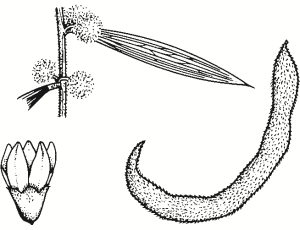Family:
Fabaceae
Acacia lanigera
Woolly Wattle
Other Names:

Name Origin:
lanigera — from Latin lana, wool, and gerus, bearing, referring to woolly hairs on ‘leaves’ and stems.
Regional Subspecies:
A. l. subsp. lanigera
Similar Species:
Occurrence:
Regional:
Noted on the drier hills of many catchments and districts, east of the Olympic Highway.
Australia:
NSW, Vic.
Habitat:
Woodland and dry sclerophyll forest, on poor gravely and sandy soil.
Habit:
Small erect or spreading shrub 50 cm to 3 m high, with rigid stems and ‘leaves’. Grey bark and flattened or angled hairy branchlets.
Site Preference:
Well-drained soils. Tolerates short periods of wetness.
Flowering:
Golden-yellow, usually Jul-Sept.
Seed Collection:
Mid Nov to early Jan, when pods are brown and curled. Monitor closely as seeds released immediately or 1-2 days after maturity.
Propagation:
From scarified seed. Pour boiling or very hot water over seeds and soak for several hours before sowing.
Regeneration:
From seed, particularly after fire. Establishes moderately well when direct seeded.
VALUES:
Shade & Shelter:
Useful low-level cover in windbreaks.
Land Protection:
Useful for stabilising soil and improving soil fertility. Legume — improves soil fertility by ‘fixing’ nitrogen.
Wildlife:
Good habitat. Flowers are a pollen source for native moths, butterflies and other native insects, and a nectar-source for birds including honeyeaters. Insect-eating birds attracted. Native birds, including parrots and pigeons eat seeds.
Ornamental:
Attractive ornamental for gardens, due to foliage and early flowering. Prune after flowering to maintain shape. Adaptable.
